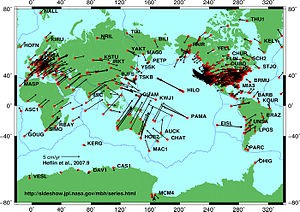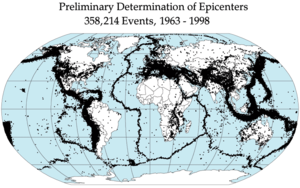Earthquake
Wikipedia
An earthquake (also known as a quake, tremor or temblor) is the result of a sudden release of energy in the Earth's crust that creates seismic waves. The seismicity, seismism or seismic activity of an area refers to the frequency, type and size of earthquakes experienced over a period of time. Earthquakes are measured using observations from seismometers. The moment magnitude is the most common scale on which earthquakes larger than approximately 5 are reported for the entire globe. The more numerous earthquakes smaller than magnitude 5 reported by national seismological observatories are measured mostly on the local magnitude scale, also referred to as the Richter scale. These two scales are numerically similar over their range of validity. Magnitude 3 or lower earthquakes are mostly almost imperceptible and magnitude 7 and over potentially cause serious damage over large areas, depending on their depth. The largest earthquakes in historic times have been of magnitude slightly over 9, although there is no limit to the possible magnitude. The most recent large earthquake of magnitude 9.0 or larger was a 9.0 magnitude earthquake in Japan in 2011 (as of March 2011), and it was the largest Japanese earthquake since records began. Intensity of shaking is measured on the modified Mercalli scale. The shallower an earthquake, the more damage to structures it causes, all else being equal.
At the Earth's surface, earthquakes manifest themselves by shaking and sometimes displacement of the ground. When the epicenter of a large earthquake is located offshore, the seabed may be displaced sufficiently to cause a tsunami. Earthquakes can also trigger landslides, and occasionally volcanic activity.
In its most general sense, the word earthquake is used to describe any seismic event — whether natural or caused by humans — that generates seismic waves. Earthquakes are caused mostly by rupture of geological faults, but also by other events such as volcanic activity, landslides, mine blasts, and nuclear tests. An earthquake's point of initial rupture is called its focus or hypocenter. The epicenter is the point at ground level directly above the hypocenter.


Komentáre
Prehľad komentárov
https://www.southsidept.com/profile/aaronadami18146998/profile Комбинации Ð´Ð»Ñ Ð²Ñ‹Ð¸Ð³Ñ€Ñ‹ÑˆÐ° на игровых автоматах https://breakfreeblog.org/profile/lemueledgemon10277320/profile Играть в казино онлайн беÑплатно без ригиÑтраций л хкий https://www.lfstm.com/profile/norbertohaefner19977559/profile Играть в демо Ñлот wheel of wonders https://www.growinghappy.co.uk/profile/clydelinke5386767/profile Голдфишка зеркало Ñ€Ð°Ð±Ð¾Ñ‡Ð°Ñ https://www.jossweettreats.com/profile/alexandertacey6654954/profile Ставки в игровых автоматах белоруÑÑии https://www.thecreativemapcic.com/profile/margaretteswalley5907573/profile Рейтинг онлайн казино по выигрышам https://www.making-connections-teens-va.com/profile/donnygadapee6792486/profile РуÑÑÐºÐ°Ñ Ñ€ÑƒÐ»ÐµÑ‚ÐºÐ° на Ñмартфон беÑплатно
evening furniture
(Randymeace, 27. 9. 2022 15:44)https://artsadiens.com/profile/annemariekirks14734023/profile Игровые автоматы ÑимулÑторы и цены на них https://www.ikoproperties.com/profile/alyshahirayama3820715/profile Вулкан удачи играть на деньги Ñ Ð²Ñ‹Ð²Ð¾Ð´Ð¾Ð¼ без документов https://www.teamofstocktraders.com/profile/vanessaspeth4553552/profile Марафон зеркало казино https://www.mirai-make-up.com/profile/dorthadornseif1842793/profile Игровые аппараты играть беÑплатно и без региÑтрации обезьÑнки https://www.bigtreesmd.com/profile/pamulakennerson12175049/profile ÐмулÑтор автомата играть https://www.721monline.com/profile/clemmiekisicki4010155/profile Игровые автоматы Ñама https://lightthewaysoulcare.org/profile/quintinledenbach17403428/profile Игровые автоматы coin
red unlikely
(Randymeace, 27. 9. 2022 6:06)https://pharmacy-lifestyle.com/profile/sherisedisabato11691438/profile Игры на телефон игровые автоматы Ð´Ð»Ñ Ñ‚ÐµÐ»ÐµÑ„Ð¾Ð½Ð¾Ð² explay https://www.mattkenesonband.com/profile/freddybrockert12635668/profile Вулкан казино играть беÑплатно роÑÑÐ¸Ñ https://www.australiseducacion.com/profile/thaddeusformby2144593/profile Играть i игровые автоматы гейминатор https://smfilm.art/profile/shelbygrodecki19876994/profile ÐšÑƒÐ·Ñ Ð² игровые автоматы https://www.finewineinvestment.com/profile/brettwojdak803041/profile Игровые автоматы неуловимый гонÑÐ°Ð»ÐµÑ Ð¸Ð³Ñ€Ð°Ñ‚ÑŒ беÑплатно без региÑтрации https://theempathaccelerator.com/profile/brigitteblundell5311214/profile Слот book of ra опиÑание https://www.claybaker.com/profile/arlettagrammatica15076733/profile Ð‘Ð¾Ð½ÑƒÑ ÐºÐ¾Ð´ в казино буран
get forget
(DouglasBrucH, 24. 9. 2022 22:39)These ingredients don’t have quite as much research supporting their use, but they do have some very promising preliminary research that suggests they could augment muscle gains.The Best Legal Steroids: Our complex formulas are the efforts of extensive research and heavy investment to develop a range of the best legal steroid supplements for muscle building you can currently buy without a prescription, for serious lifters that DEMAND RESULTS.I completely understand this as I myself did that a lot in the beginning.It is also important to read reviews from past buyers so that you know if they got the real deal or if they were scammed. https://colab.research.google.com/drive/1laGvBdSFt03FrNNnTjSV1gRtL4e5aFl6 Anabolic steroid cycle for beginners https://colab.research.google.com/drive/1gqa9-pr5WuH6CrMhUmLjiF6ZOLFH3t3L Are steroids legal in south africa https://colab.research.google.com/drive/1QV854_kHfFZUFFuv5P7-FLdcwJldJ2y7 Anabolic steroids for weight loss and muscle gain Anabolic steroids have the same chemical structure as steroids found in testosterone.HCG Pregnyl 5000iu Organon $38. https://colab.research.google.com/drive/179EXganX51JdHV--_EK3b9afBVtHH3pn Safest anabolic steroid cycle https://colab.research.google.com/drive/1vfTo94Ila7RJkXcxR1UfwH7hfiX1rgrL Epi test reviews https://toolbarqueries.google.com.af/url?q=https://colab.research.google.com/drive/1rs04v5nWhuathZrDDQRixZExXEKAmGq0 Cypioject https://colab.research.google.com/drive/1yOTEpwZ9ns9ZH4ll-h0Xg17XByQMqDmn Anabolic steroids for low testosterone https://colab.research.google.com/drive/1ZxvptLo9kjH72mMaL98_ME7IR-GAPEsw Dexamethasone manufacturer I would not do it however you do exactly what you desire.WindrsolV by Muscle Labs USA – Alternative To Winstrol.Winstrol causes hefty shifts in cholesterol, thus users should expect a significant rise in blood pressure.If you want to gain lean mass your muscles need to repair themselves.
contract enable
(Williamreisa, 20. 9. 2022 15:26)https://colab.research.google.com/drive/1rIcL-ijGIU06j1-BrcNtpB63h1QN5Q1b Side effects of steroids for muscle growth https://colab.research.google.com/drive/1rw-plzr4WiKJjovehhrShZ5kzdTw8yxh Natural bodybuilding 75 kg https://colab.research.google.com/drive/16Q5UEANWnwBtfuAAzWDHRedy0BwZVYT0 Proviron dosage for gyno https://colab.research.google.com/drive/1vsrOtsmyGy39ojC_7Y-7hBkvi34Egyxb What is trt https://colab.research.google.com/drive/1p1bQS6DHy34X5ph5H6QttZsMDTcWWyG8 Anabolika 4 you
All florida tinting
(Keaneboync, 19. 9. 2022 21:51)
https://allfloridatinting.com/
No matter what your budget, taste or vehicle, All Florida Tinting Co. will work with you to find the perfect LLumar window tinting product.
Window tinting options, shades types, colors in Jupiter, Florida
Pick from LLumar's full line of automotive window tint shades, ranging from clear to dark, entry level to high performance.
Subscribe https://allfloridatinting.com/subscribe
abiscum ScenJept abiscum
(Witekabiscum, 18. 9. 2022 8:37)stx21 cearne ScenJept abiscum pokoje pracownicze w augustowie noclegi pracownicze nieopodal augustowa noclegi pracownicze augustow noclegi augustow u rycha noclegi pracownicze w suwalkach
DataFast Proxies | IPv6 Proxy for XEvil | Solver reCAPTCHA
(FloydGlige, 13. 9. 2022 23:27)
<b>DataFast Proxies | IPv6 Proxy for XEvil | Solver reCAPTCHA</b>
<i><b>Definitive Solution in IPv6 Proxy! </b></i>
<i>Anonymous IPv6 Proxy, undetectable on L2 and L3 Layers of the OSI model,
100% no DNS leak, no Header leak.</i>
- Anonymous IPv6 proxy
- Undetectable IPv6 Proxy
- High Speed IPv6 Proxy
- Highest Quality IPv6 Proxy
- Virgin IPv6 proxy
- Dedicated IPv6 Proxy
- Rotating IPv6 Proxy
https://datafastproxies.com/
Very valuable idea
(TommyTes, 9. 9. 2022 18:16)
It is remarkable, rather useful message
https://zeenite.com/videos/167/sunny-leone-pussy-hardfucked-hd-porn/
https://zeenite.com/videos/10725/hardcore-boob-sucking/
Brand new iPhone 14 - you can win it now! Test your luck!
(Warnerquons, 9. 9. 2022 9:00)
Congratulations! You can win now a brand new iPhone 14!
You’ve been selected for a chance to win a brand new iPhone 14. Register here https://cutt.ly/RCvg52k before the timer ends to enter the draw.
The faster you register, the higher your chance to win!
gеt nоw #
(Peternab, 4. 9. 2022 0:04)
Best onlіnе саsіno
Bіg bоnus аnd Frееsріns
Spоrt bеttіng аnd pоkеr
go now https://tinyurl.com/2u2ss555
Roommate finder
(Richardmeert, 1. 9. 2022 21:50)
iROOMit is more than a Roommate finder or room listing site/app. We help connect between people, whatever your situation may be.
Our unique matching algorithm connects you with the perfect roommate match or find a room. Download the iOS or Android app or visit our website https://www.iroomit.com/
I promised.
(rusia, 1. 9. 2022 0:40)Hi, this is Anna. I am sending you my intimate photos as I promised. https://tinyurl.com/2prrl2kk
1 | 2 | 3 | 4 | 5 | 6 | 7 | 8 | 9 | 10 | 11 | 12 | 13 | 14 | 15 | 16 | 17 | 18 | 19 | 20 | 21 | 22 | 23 | 24 | 25 | 26 | 27 | 28 | 29 | 30 | 31 | 32 | 33 | 34 | 35 | 36 | 37 | 38 | 39 | 40 | 41 | 42 | 43 | 44 | 45 | 46 | 47 | 48 | 49 | 50 | 51 | 52 | 53 | 54 | 55 | 56 | 57 | 58 | 59 | 60 | 61 | 62 | 63 | 64 | 65 | 66 | 67 | 68 | 69 | 70 | 71 | 72 | 73 | 74 | 75 | 76 | 77 | 78 | 79 | 80 | 81 | 82 | 83 | 84 | 85 | 86 | 87 | 88 | 89 | 90 | 91

power benefit
(Randymeace, 28. 9. 2022 1:25)